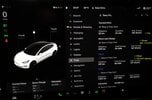@AAKEE
My MYLR 2023 giga Shanghai went to sleep 2 days ago
The SoC at the start of the sleep was 30%. This was just after arriving home from 70km drive = end of drive SoC
2 days later I opened door and pressed brake. The SoC is 29% no sentry = after a sleep SoC
Looks like the BMS is about spot on.
I will drive it 60km without charging on Sunday. At end of drive I will charge to SoC 50%. Let me know what screenshots you want of the energy app
60 km might be a little on the low side, I guess. I would prefer to see 150km or 100 miles driven. Just using the SOC/range we probably need a longer drive.
It probably also is better to drive at a decent speed and not too fast.
I have done all my checks on drives to the work, 240km.
But even with only 60km driven, if we see a change in range after the drive it is a indication as from the describtion below.
If the BMS was way off, it would probably be enough to show if it was over- or underestimating.
In your case, as you ”only” lost 1% after two days, your BMS is probably showing about right.
The basics for this is:
We expect the BMS to be spot on = no change of SOC/displayed range after the sleep.
Range decrease after the sleep = overestimation of the capacity.
Range increases sfyer the sleep = underestimation.
This version is a simplification from doing the same with Scan My Tesla which will give a more precise result. I did a few double checks from the displayed range and they basically show the same result as with Scan My Tesla, but as the resolution is lower, so a longer drive would compensate for this.
——————————————————————
Before the drive, let the car sleep (after the charge etc) to make it record the correct ”true” SOC. This is important as we need a BMS starting the estimation from a correct SOC.
After the drive you should record these numbers after the drive:
-SOC and range (in km) at end of the drive. Take this value asap, before any readjustment happens.
-Used energy for the last drive. The total kWh might be fine but [distance x average consumption] gives a more exact result.
-After the car has been parked/locked/sleeping for 30 minutes or more: -SOC and range (in km).
The change in range (or SOC) after the sleep indicates the BMS capacity estimation error.
Each change in range/km = about 0.15kWh, or the actual constant for your car.
(Used energy +/- delta energy)/(Used energy) = the correction factor for the BMS estimated capacity / range.
For example:
Used energy = 50 kWh
Range decreased from 100 to 93km after the sleep = 7 km delta = 1kWh.
(50-1)/50 = 0.98.
The true capacity is 98% of the BMS estimated capacity.
The BMS is overestimating the capacity if this number is below 1, and underestimating if it’s above 1.
Displayed maximum range or calculated capacity from the energy app can be adjusted by multiplication by the correction factor.
——————————————————————
We expect the change in range to be very low. No change means the BMS is estimating the capacity correct.
I’ll be back later with the use of Scan My Tesla to calculate the capacity.



